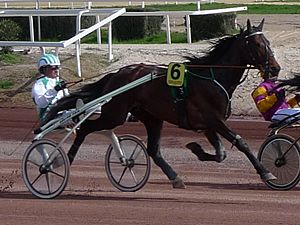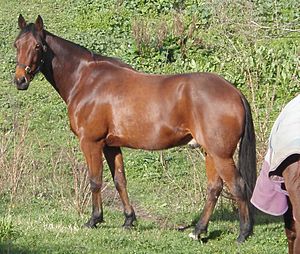Standardbred facts for kids
The Standardbred is an American horse breed. These horses are famous for their speed in harness racing. In these races, Standardbreds either trot or pace. The breed started in North America. It is now known all over the world. Standardbreds are strong, well-built horses with calm personalities. Besides racing, they are used for many other horse activities. These include horse shows and pleasure riding. They are especially popular in the Midwestern and Eastern United States and in Southern Ontario.
Contents
History of the Standardbred
In the 1600s, the first trotting races happened in America. Horses usually ran in fields with riders on their backs. By the mid-1700s, trotting races moved to special tracks. Horses in these races wore harnesses. Many horse breeds helped create the Standardbred. These included the Narragansett Pacer, Canadian Pacer, Thoroughbred, Norfolk Trotter, Hackney, and Morgan.
The main ancestor of the Standardbred is a Thoroughbred horse named Messenger. He was born in England in 1780. Messenger was a gray stallion brought to the United States in 1788. He had many fast flat racing horses as offspring. But he is best known for his great-grandson, Hambletonian 10. This horse was also called Rysdyk's Hambletonian. He was born in 1849. Hambletonian 10 is seen as the main father of the Standardbred breed. All Standardbreds today can trace their family tree back to him.
Hambletonian 10's mother had Norfolk Trotter horses in her family. A farm worker from New York, William Rysdyk, bought the mare and her foal. He successfully raced the young horse when it was three years old. Hambletonian 10 later had 1,331 offspring. Forty of them could trot a mile in less than 2 minutes and 30 seconds.
Another important father horse was the Thoroughbred Diomed, born in 1777. Diomed's Thoroughbred grandson, American Star, was born in 1822. He was important because his daughters were bred with Hambletonian 10. As harness racing became more popular, breeders carefully chose horses to make faster trotters.
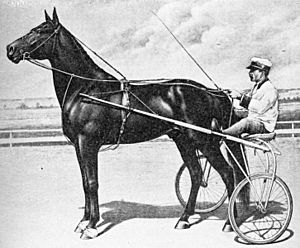
The Standardbred breed registry was created in the United States in 1879. It was formed by the National Association of Trotting Horse Breeders. The name "Standardbred" came from the "standard" these horses had to meet. To be part of the breed, a horse had to trot or pace a mile within a certain time. Every Standardbred had to be able to trot a mile in under 2 minutes and 30 seconds. Today, many Standardbreds are much faster than this old standard. Some pacers can run a mile in under 1 minute and 50 seconds. Trotters are only a few seconds slower than pacers. Trotters and pacers have slightly different family lines. But both can trace their history back to Hambletonian 10.
What Standardbreds Look Like
Standardbreds usually have more muscle and longer bodies than Thoroughbreds. They also have calmer personalities. This suits them well for races that need more planning and changes in speed. Standardbreds are known to be friendly and easy to train.
They are a bit heavier than Thoroughbreds. But they have strong, refined legs. Their shoulders and back legs are very powerful. Standardbreds come in many heights, from 14 to 17 hands (56 to 68 inches, 142 to 173 cm) hands tall. Most are between 15 and 16 hands (60 and 64 inches, 152 and 163 cm) hands. Their most common colors are bay, brown, or black. Other colors like chestnut are also seen. Sometimes you can find gray and roan Standardbreds too.
A typical Standardbred weighs between 800 and 1,000 pounds (360 and 450 kg). Their heads are refined and straight. They have wide foreheads, large nostrils, and shallow mouths. The body of a Standardbred is usually long. Their withers (the ridge between the shoulder blades) are well-defined. They have strong shoulders and long, heavy muscles. These muscles help them take long strides. The Standardbred's neck is muscular and should be slightly arched. It is usually medium to long in length. Their legs are muscular and strong. They often have very tough and durable hooves.
Individual Standardbreds usually either trot or pace. Trotters prefer to race at a trot. In a trot, the horse's legs move in diagonal pairs. For example, when the right front leg moves forward, the left back leg also moves forward. The pace is a two-beat gait. In a pace, the horse's front and back legs on the same side move together. Standardbreds can also do other horse gaits, like the canter. However, using the canter is not allowed in harness racing.
The ability to pace is linked to a small change in a gene called DMRT3. This gene helps control how a horse's legs move. The change in the gene makes it stop working early. This changes how the horse's body coordinates its limb movements.
What Standardbreds Are Used For
Harness Racing
Standardbreds are famous for their skill in harness racing. They are the fastest trotting horses in the world. Because they are so fast, Standardbreds are often used to improve other harness racing breeds. Examples include the Orlov Trotter and French Trotter.
In Australia, Canada, New Zealand, the United Kingdom, and the United States, races are held for both trotters and pacers. In Europe, all harness races are only for trotters. Some big races for North American trotters include the Peter Haughton Memorial for two-year-olds. For three-year-olds, there's the World Trotting Derby, Yonkers Trot, Hambletonian, and Kentucky Futurity. The Hambletonian is sometimes called the "Kentucky Derby of Harness Racing." The Trotting Triple Crown includes the Yonkers Trot, Hambletonian Stakes, and Kentucky Futurity.
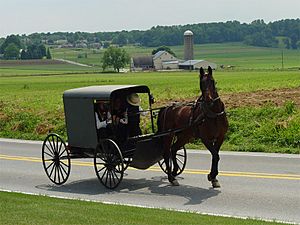
Some major pacing races in North America are the Woodrow Wilson and Metro Stake for two-year-olds. For three-year-olds, there's the Little Brown Jug, Meadowlands Pace, North America Cup, and the Adios Pace. The Little Brown Jug, the Messenger Stakes, and the Cane Pace make up the Pacing Triple Crown. Important races in Australia and New Zealand include the New Zealand Trotting Cup, the Miracle Mile Pace, and the Inter Dominion series.
In 1968, a New Zealand-bred horse named Cardigan Bay became the first Standardbred to win US$1 million. He was the ninth horse in the world to do this. The first eight were Thoroughbreds. Cardigan Bay was very popular in the United States. He even appeared with Stanley Dancer on The Ed Sullivan Show. He was known as the "million dollar horse."
Other Uses
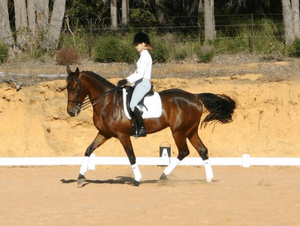
Standardbreds are also used in horse shows and for pleasure riding. They are popular as light buggy horses for the Amish people. The Amish do not use motorized vehicles. Many retired Standardbreds find new jobs after racing. Organizations like the Standardbred Pleasure Horse Organization help them.
This breed is quite good at jumping. This makes them suitable for sport horse activities. These include hunt seat, show jumping, show hunter, and eventing. Standardbreds are also seen in dressage. Their calm temperaments make them good trail riding and ranch horses.
Because of their genetics, Standardbreds can also be trained to do smooth ambling gaits. These include the rack and the stepping pace. The number of gaited Standardbreds is growing in the United States. Some farms focus on breeding horses with this special trait. Standardbreds are also becoming popular in Australia for endurance riding. They are used for rides from 20 km to 80 km. They are known for their strong bones and good body shape. They can also keep high trotting speeds for a long time comfortably. The breed's kind and easy-to-manage personality also makes them popular. These features are especially good for riders who don't want to compete against Arabian horses. Arabians are often more challenging to ride.
See also
 In Spanish: Standardbred (raza de caballos americana) para niños
In Spanish: Standardbred (raza de caballos americana) para niños


